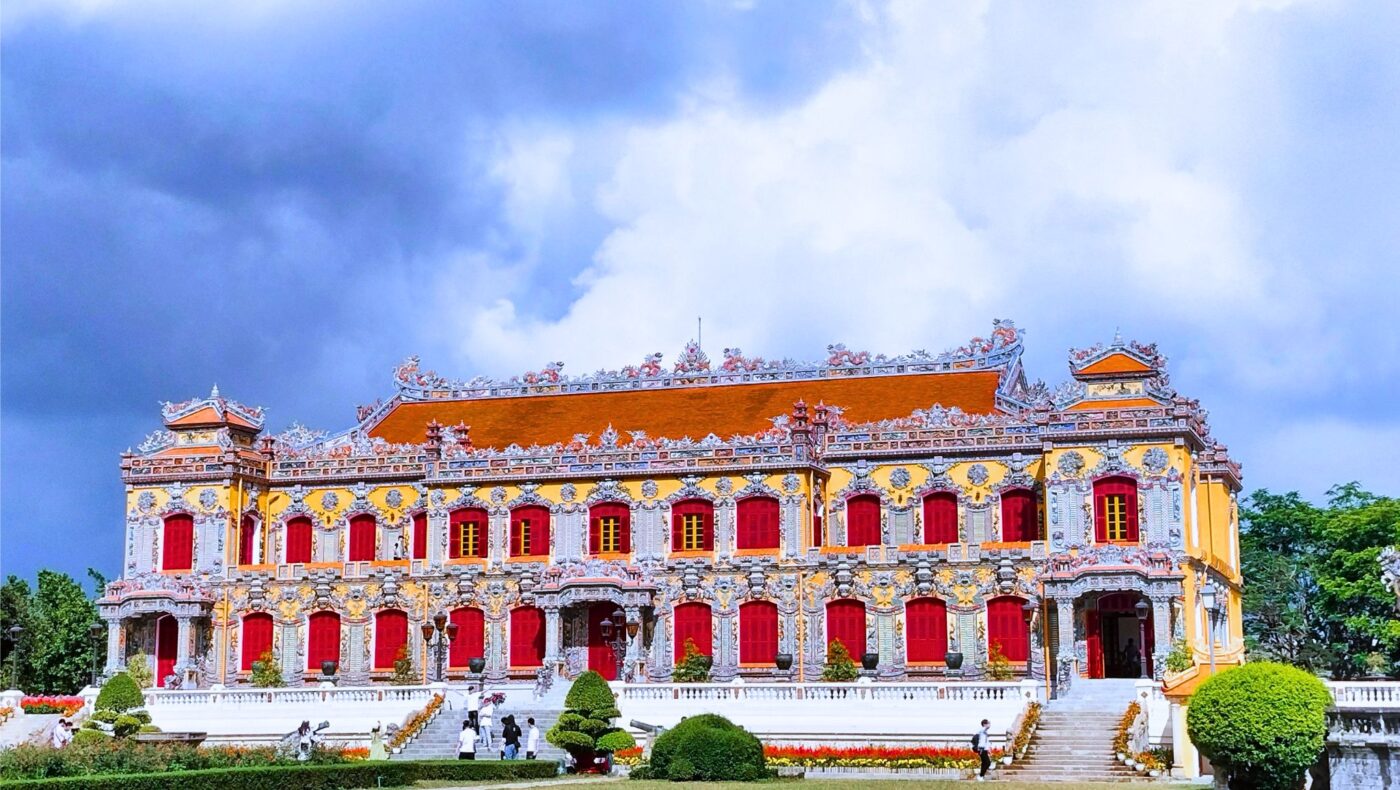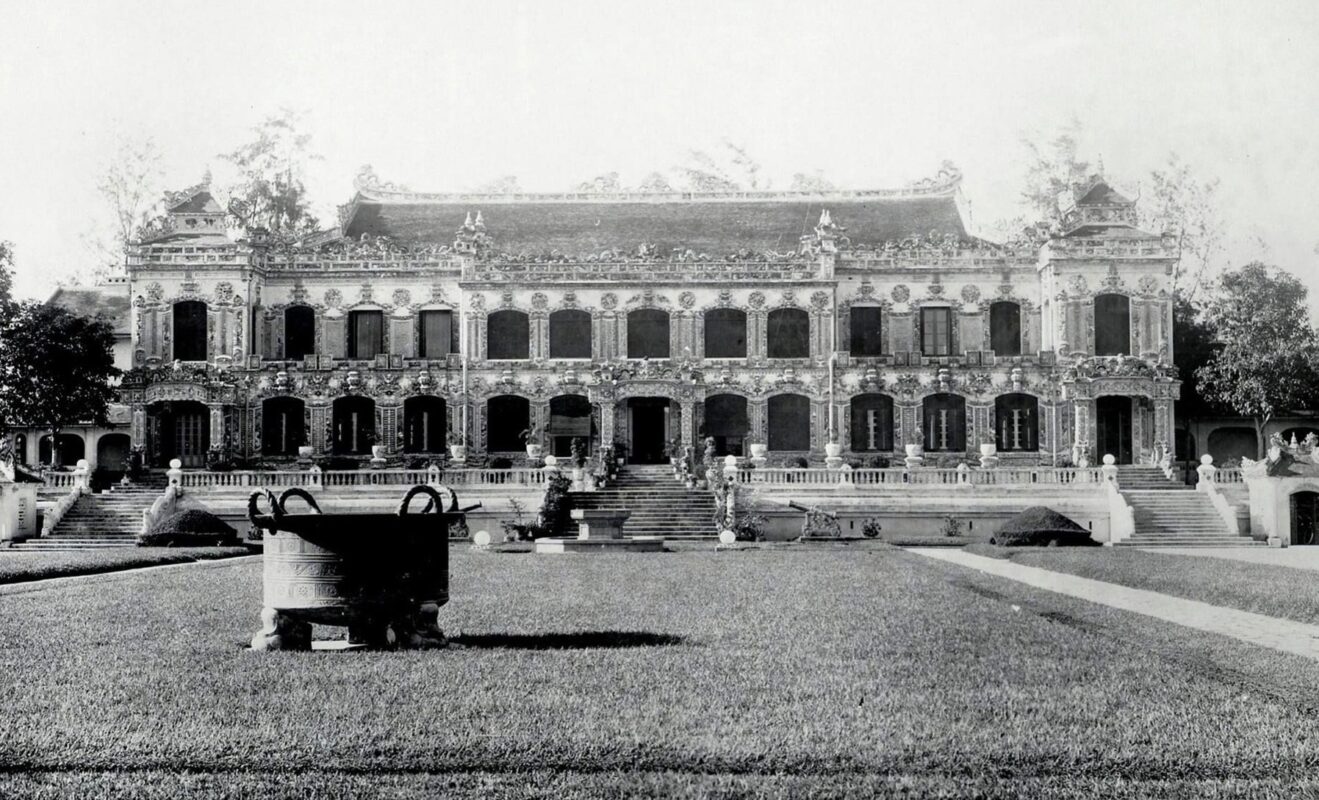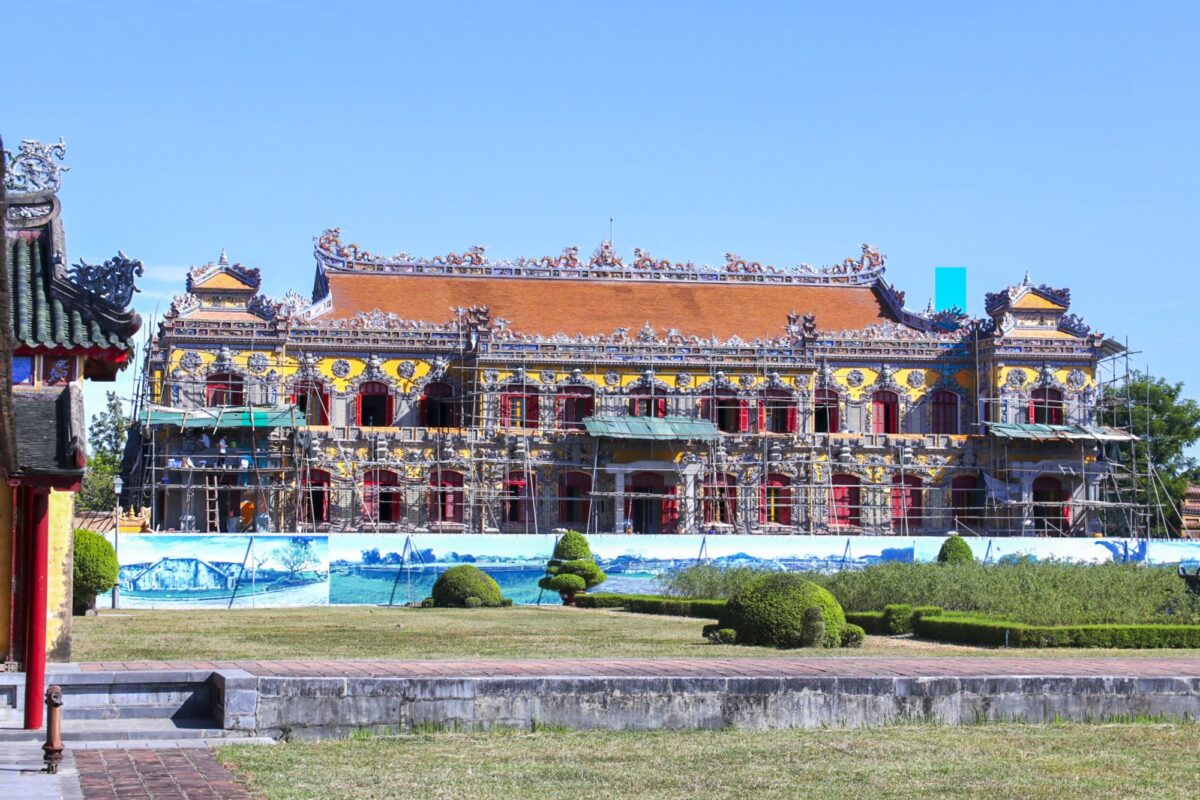1. What is Kien Trung Palace? – Introduce Kien Trung Palace
Kien Trung Palace is an architectural work inside the Hue Imperial City.
After an undergoing through five-year renovation, Kien Trung Palace finally reopened to the public in the January 2024. This royal residence, which combines the grandeur of the Nguyen Dynasty with Western architectural influences, reflects King Khai Dinh’s vision. It was under his decree that the palace, symbolizing strength and integrity with its name “Kien Trung,” was built.
.

2. History of Kien Trung Palace
Initially, this site featured two distinct structures: Minh Vien Pavilion and Du Cuu Pavilion. Construction of Minh Vien Pavilion began in 1827 during Emperor Minh Mang’s reign. This impressive three-story wooden pavilion, standing 15.8 meters tall, served as a tranquil retreat for the emperor, offering a serene space to enjoy the scenery and fresh air.
Later, Emperor Thieu Tri restored the pavilion, adding a radiant pearl to its roof, which illuminated the structure at night. He praised Minh Vien Pavilion as the most beautiful scene in the “Twenty Views of the Capital.” However, by 1876, during King Tu Duc’s reign, the pavilion was demolished due to severe deterioration.

3. The Restoration of Kien Trung Palace
On February 16, 2019, the Hue Monuments Conservation Center launched a significant restoration project for Kien Trung Palace. Covering over 3,800 square meters, the initiative aimed to preserve the palace’s original foundations while maintaining its historic integrity with minimal alterations. Given the palace’s complex design and intricate decorations, the restoration demanded meticulous precision and attention to detail.
The project involved reinforcing and repairing perimeter walls, railing systems, and courtyard layouts, including both the front and rear courtyards. Restored to its original two-story configuration, Kien Trung Palace now stands approximately 14 meters high with a construction area of about 975 square meters.
In addition to the main structure, the restoration also included updating many smaller elements around the site, such as the brick foundation, fountain base, artillery base, guard house, and landscaping. The foundations of the Eastern Palace, the Royal Archives, the Military Hall, and the Royal Library were also renovated. With 123.78 billion VND from the cultural development program fund and other legal sources, the restoration was completed in early February 2024.

4. Architecture of Kien Trung Palace
Kien Trung Palace stands out for its blend of architectural influences, combining Italian, French Renaissance, and traditional Vietnamese styles into a unique structure. In front of the palace is a beautiful landscaped garden, with three staircases decorated with exquisitely crafted dragon motifs leading up to the main gate of the palace. Here, the main floor has 13 patio doors, including a central set of 5 doors, 3 on each side. The design of the upper floor mirrors the design of the main floor.
The palace’s roof has many outstanding patterns and dragons, is intricately inlaid with porcelain, and is decorated with motifs such as flowers, birds, etc. The tiled roof is flat and finished with a layer of transparent yellow enamel, and the window frames are painted yellow and red.

The walls of the palace were similarly decorated with mosaic porcelain, featuring dragon and rooster designs, which required the skilled combination of various pieces of porcelain to achieve a lifelike appearance.
Overall, Kien Trung Palace is a testament to the progress of Vietnamese architecture in the neoclassical period, especially highlighting the sophisticated ceramics of the Nguyen Dynasty, a prominent feature in the architectural style. The Nguyen Dynasty’s Royal Palace.
5. The Antiques Inside Kien Trung Palace
After being restored, the Hue Monuments Conservation Center meticulously researched the rich history of Kien Trung Palace to properly manage the collection of antiques associated with King Bao Dai and Khai Dinh.
Valuable antiques are preserved and displayed at the palace by the Conservation Center. They include items such as King Khai Dinh’s daily vestments and shoes, his daily attire, and the golden dragon-decorated shoes of Crown Prince Vinh Thuy, who later became King Bao Dai (1926). In addition, the collection includes shields, tables, chairs, vases and cabinets beautifully inlaid with conch shells.
Particularly outstanding are the two pairs of shoes of King Khai Dinh, one pair used in official ceremonies and one pair used for daily use. Another highlight is the dragon and phoenix embroidered shirt frequently worn by King Khai Dinh, attracting attention thanks to its sophisticated details. The gallery also has porcelain plates that were once used in the Royal Palace.
6. Opening Hours And Entrance Fee of Kien Trung Palace
Summer: 6:30 AM – 5:30 PM
Winter: 7:00 AM – 5:00 PM
Kien Trung Palace is situated within the Hue Citadel, making it accessible with just a single entry ticket to the Hue Imperial City. For a fee of only 200,000 VND per person, you gain admission to both this magnificent palace and the entire complex of the Hue Citadel.
7. Interesting experience inside Kien Trung Palace
8. Notes when visiting Kien Trung Palace
Kien Trung Palace is one of the palaces located in Hue Imperial . In addition, there are many other unique architectural areas that you can combine to visit such as: Ngo Mon Gate, Thai Hoa Palace, Dien Tho Palace,..
Some notes when visiting Kien Trung Palace:
You should choose appropriate clothing, both to maintain politeness when entering the relics, and to be able to take photos and preserve beautiful moments.
You should comply with the regulations at the relics, do not record interiors or touch artifacts.
Ensure general hygiene
9. Conclusion
In conclusion, Kien Trung Palace in Hue stands out not only for its profound historical, cultural and architectural values but also as a popular destination for many tourists when visiting the ancient capital of Vietnam. This palace provides an insight into the royal architecture of the Nguyen Dynasty and displays an unique collection of historical artifacts and documents. We hope this information helps you better to understand Kien Trung Palace. SAMTOUR hopes to accompany with you when visiting and exploring the culture and history of Hue City, thereby bringing memorable experiences and unforgettable impressions to visitors when coming to hue




